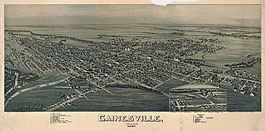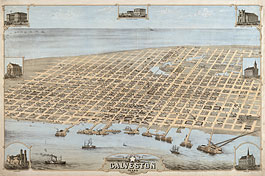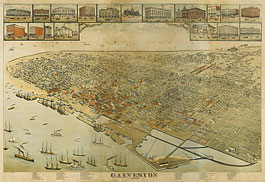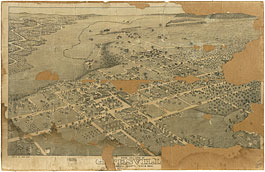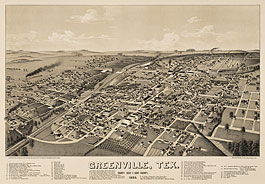Gainesville in 1891
Gainesville continued to grow in the years between Augustus Koch’s visit in 1883 and Thaddeus Fowler’s in 1891, due partly to the arrival of two additional railroads: the Santa Fe in 1886 and the Gainesville, Henrietta and Western Railway in 1887. Almost 6,600 persons called the city their home by 1890, perhaps double the population of 1883. Unlike some communities that suffered when the trail drives came to an… [More]
Galveston in 1871
The bird’s-eye-view phenomenon began in Texas when the editor of the Galveston Daily News announced in his March 10, 1871, edition that “Mr. C. Drie exhibited to us some drawings that he is making for a map of Galveston, which will exhibit the buildings on every lot within the city. It is an isometric projection, and promises to be a fine picture of the Island City, and will be… [More]
Galveston in 1885
Augustus Koch’s view of Galveston in 1885 reveals how much the city had grown in the fourteen years since Camille M. Drie depicted it in 1871. Shown from the northwest, both views focus on the downtown commercial district and the port facilities on Galveston Bay, the narrow strip of water between the mainland and the island. Galveston was the largest city in the state and the third largest cotton… [More]
Gatesville in 1884
As with many cities in the late 1800s, Gatesville was recovering from a fire. The rebuilding had already begun when Koch made this view, and the Texas and St. Louis Railroad, which initiated service from Waco in October 1882, had accelerated growth in this small Central Texas community. Gatesville was primarily a regional agricultural center, with Benjamin Worley’s Flour and Planing Mill and Cotton Gin operating on Still House… [More]
Greenville in 1886
Wellge continued his tour of the North Texas cotton-farming country with a visit to Greenville late in 1885. Prior to the arrival of the railroads, Greenville had been what one historian called an “inland island,” thirty miles from a railroad in any direction and a modest producer of traditional agricultural crops. But an increase in the number of slaves before the Civil War and the arrival of the railroads… [More]











